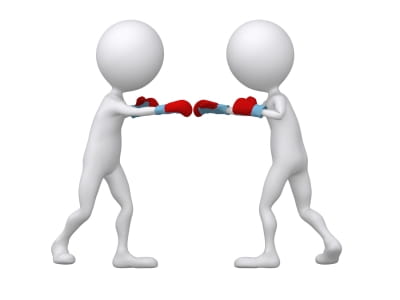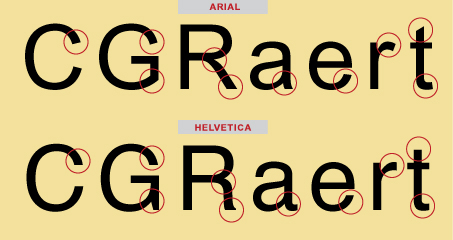History, in general, is full of facts that are subject to personal interpretation and not always solely based on concrete data. The same can be said for the history of Arial font; ripoff or inspired design? We decided to take a look at this debate and share what we’ve learned.
If you are a designer or typographer chances are you have developed your own opinions. For the professional the answer may seem obvious, Arial is a knockoff of Helvetica. But at a closer glance, the nuances of Arial typeface do set it apart

Evolution of Typeface Design: A Historical Perspective
The evolution of typeface design spans centuries, reflecting shifts in technology, cultural trends, and aesthetic preferences. The debate between Arial and Helvetica encapsulates this evolution, raising questions about originality, influence, and the nature of design itself. let's look at Helvetica and arial font history.
Historical Precedents: Tracing the Roots of Typeface Design
Before Helvetica and Arial entered the scene, typefaces like Akzidenz Grotesk laid the groundwork for modern sans-serif fonts. Developed in the late 19th century, Akzidenz Grotesk represented a departure from the ornate, serifed styles of traditional typography. Its clean lines and minimalistic aesthetic set a precedent for the emergence of Helvetica decades later.
Helvetica: A Modern Classic Emerges
Max Miedinger's creation of Helvetica in 1957 marked a milestone in typeface design. Inspired by Akzidenz Grotesk, Helvetica refined and modernized the sans-serif genre, offering unparalleled legibility and versatility. Its widespread adoption by corporations and designers alike cemented its status as a timeless classic, embodying the principles of Swiss design and functionalism.
Arial: Innovation or Imitation?
When was Arial font created? The introduction of Arial in 1982 sparked controversy within the typographic community. While its creators, Robin Nicholas and Patricia Saunders, positioned Arial as an original design, its striking resemblance to Helvetica raised eyebrows. Critics argued that Arial's similarities amounted to little more than a copycat strategy, challenging notions of authenticity and artistic integrity.
While Arial has been criticized for being a scourge of typography, it remains a popular choice for advertising and promotions. It copies Helvetica's proportions and stroke width, making it a cohesive font family for various design projects. Arial's versatility has led to its widespread use in magazines, etc.
Another well-known sans-serif font, Gill Sans, is often compared to Arial in terms of design. However, Arial's terminal strokes and overall look set it apart from other fonts in the same category. Its clean and modern design makes it a font of choice for many designers, alongside Calibri, another popular font from the Arial family.
Despite its success, Arial continues to be overshadowed by fonts like Times New Roman and Monotype Grotesque. However, its close resemblance to Helvetica and wide availability have solidified its place as a key font in modern design.
The Rise of Digital Typography: Implications for Design Ethics
The proliferation of digital typography in the late 20th century transformed the landscape of graphic design. As technology made typefaces more accessible and customizable, questions of ownership and attribution became increasingly complex. The case of Arial versus Helvetica exemplifies these tensions, prompting discussions about intellectual property rights and ethical standards in design practice.
Helvetica font vs Arial
History of Helvetica
Helvetica typeface was designed in 1957 by Max Miedinger. Miedinger based his design on that of Akzidenz Grotesk 1896 which was classified as Grotesque san serif face.
With its friendly, cheerful appearance and clean lines, it was universally embraced for a time by both the corporate and design worlds as a nearly perfect typeface to be used for anything and everything. “When in doubt, use Helvetica” was a common rule. Mark Simonson

Arial history
In 1982, Robin Nicholas and Patricia Saunders created the Arial typeface for Monotype and labeled it Neo Grotesque. Essentially, it’s an “original” design that just happens to share exactly the same proportions and weight as another typeface, as stated by Mark Simonson. In other words, it’s a copy with very few differences to be able to call it a unique typeface.
Arial is everywhere!
Some say that Arial was created by Microsoft for their Windows 3.1 so that they could avoid paying licensing fees and save money. Whatever you choose to believe, you most likely use Arial everyday without thinking about it much. The popularity of Windows 3.1 has made Arial a household name. Microsoft understood that the average person could not tell the difference between Helvitica and Arial and -more importantly- they would not care. It seems they were right in their thinking.
Today, a version of Arial font can be seen everywhere, from academic papers to advertising design, and has knocked Helvetica out of the top spot for the last 30 years. The Arial vs Helvetica debate is still strong amongst those in the typography industry and font historians. (Also among designers and Type lovers!) The best way to get a sense of the similarities and differences is to place the typefaces side by side. Only individual tastes can say which font reigns supreme.
The Differences: Under the microscope!
Let’s take a look at the lower case “a” side by side. What do we see? In Helvetica, the lowercase “a” has a tail unlike the Arial version which does not. If we put capital C’s side by side, we can see that in Helvetica the ends of the strokes of letters like “C” are perfectly horizontal. In the case of Arial, the ends of the “C” are cut at a slight angle.
The differences are subtle, but they are apparent. Some may say that if Arial is a rip-off of Helvetica, then Helvetica is a rip-off of Akzidenz Grotesk, or we could simply say that they are both rip-offs of earlier Grotesque faces. As in most areas of life, there are very few originals, just adaptations. After all, imitation is the best form of flattery, right?
Ripoff or inspired design?
The choice is really yours, we just had fun presenting it to you! Remember you can use any of these fonts on the 4over4.com online design tool which offers custom trims and countless print templates for all your design needs.
Tell us which typeface you would choose for your print designs. Our curious minds want to know!
FAQs
Q: What is the difference between a serif and a sans serif font?
A: A serif font has decorative lines or strokes at the ends of characters, while a sans serif font does not have these decorative strokes.
Q: Why did Microsoft choose Arial as its default font for Windows?
A: Microsoft chose Arial because it is a contemporary sans serif font that is easy to read on screens and in print.
Q: Is Arial part of the Helvetica font family?
A: Arial is not part of the Helvetica font family, but it does share some similarities with Helvetica in terms of proportions and stroke width.
Q: What is the significance of the Arial font family in typography?
A: Arial is a widely used font family known for its clean and modern appearance, making it a popular choice for a variety of design projects.
Q: Can you explain the relationship between Arial and Helvetica?
A: Arial was designed as a typeface that copies some of Helvetica's proportions and stroke characteristics, but it is not an exact replica of Helvetica.
Q: Why is Arial sometimes referred to as the "scourge of typography"?
A: Some designers criticize Arial for its lack of originality and for being overused, leading to its nickname as the "scourge of typography."
Q: Who created Arial font?
Arial font was created by Monotype Typography in 1982 as an alternative to Helvetica. It is a sans-serif typeface known for its softer and fuller treatment of curves compared to Helvetica. Arial is often used as the core font in Microsoft Windows operating systems, serving as the default font in many applications.
Q: What are some other fonts in the Arial font family?
A: Other fonts in the Arial font family include Arial Black, Arial MT, and fonts that are variations or extensions of the original Arial typeface.








